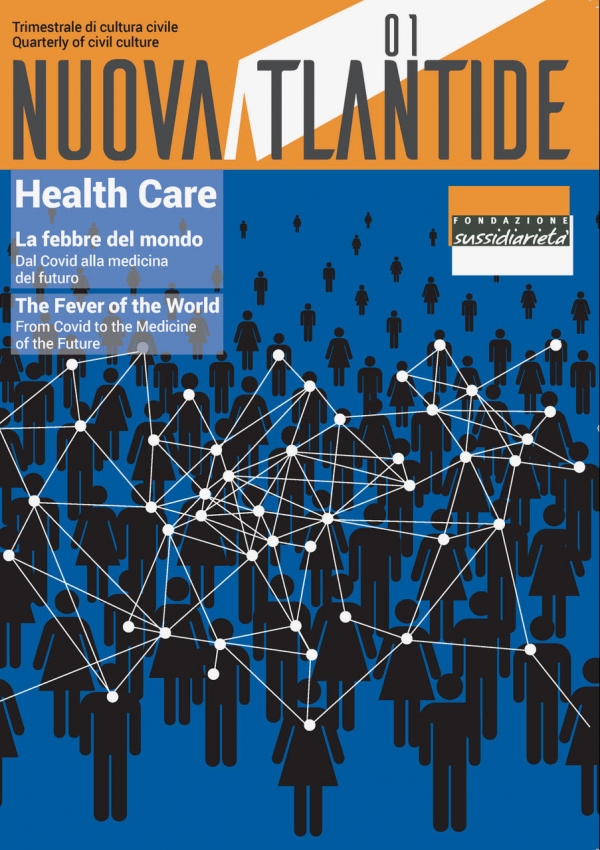The numbers of people harmed by the pandemic continues to grow and dramatically and underscores the serious international public health and economic situation. Right now, global leaders are being called on for a deeper reflection in order to change the underlying situation that led to the present calamity. We need to be asking better questions and harvesting much better lessons from the past year to prepare to the future.
The U.S. public health system has been starved for decades and lacks the resources to confront the worst health crisis in a century. The health care system deficit has spared nobody, Europe included. Understanding what went wrong is the right way to start putting population health strategic relaunch choices into play.
As we confront the most devastating infectious disease epidemic of the past 100 years, we must realize that many more serious illnesses and avoidable deaths are likely, not just from Covid-19 but as a consequence of the social disruption it has caused, including the fear, and lack of trust, and structural dysfunction of accessing and paying for medical care. Numerous reports have documented a marked drop in vaccinations and primary prevention services, and an increased number of patients with heart disease, strokes, and other acute diseases who have been harmed or died because they were afraid to seek medical care during the pandemic1 .
Everywhere people are asking “How could this have happened? Why were nations caught sleeping? If they knew, why did they not act?” These questions will settle, as they should, soon at the doorsteps of policy makers and elected leaders. They will need a deep reflection and humility, good answers and better plans.
The goal of this paper is to help policymakers reflect at all levels and learn from mistakes so they can recognize and address the unprecedented challenges to society and healthcare systems presented by the rapidly expanding health, political and social crises.
The coronavirus exposed USA and European countries’ misplaced confidence in faulty public health models, bureaucratic busywork and their own arrogance.
Western Europe became an epicenter of the pandemic. The foundations of preparedness, most crucially a robust public health system, have been allowed to erode or have never been laid in the first place. Several major reports in the past decade have tried to call attention to that lack of readiness, with only minimal response. Officials once boastful about their system preparedness were frantically trying to secure protective gear and materials for tests, as death rates soared in Britain, France, Spain, Italy and Belgium. Other aspects are emblematic of the profound obstacles that leaders in Italy and Europe faced in recognizing the magnitude of the threat posed by Covid-19, and organizing a systematic response to it, and learning from early implementation successes – and, most importantly, failures.
It is worth emphasizing that these obstacles emerged even after Covid-19 had already fully impacted in China and some alternative models for the containment of the virus (in China and elsewhere) had already been successfully implemented. What this suggests is a systematic failure to absorb and act upon existing information rapidly and effectively rather than a complete lack of knowledge of what ought to be done.
The pandemic plans were built on a litany of miscalculations and false assumptions about the robustness our healthcare systems. Western leaders boasted of the superiority of their world-class health systems but had weakened them with a decade of cutbacks while ignoring the need to transform healthcare systems using the Quadruple aim2 – four interdependent goals consisting of (1) enhancing patient experience and safety, (2) improving population health, (3) reducing costs and preventing loss of revenue, and (4) improving wellness and satisfaction of healthcare workers. The fourth aim incorporates the increasing understanding that excellent healthcare is not possible without a physically and psychologically safe and healthy workforce (HCW).
When Covid-19 arrived, those systems were unable to test or trace or predict widely enough to see the peak coming – or to guarantee the safety of health care workers after it hit.
Accountability mechanisms proved toothless. Thousands of pages of national pandemic planning turned out to be little more than exercises in bureaucratic busy work. Officials in some countries ignored and boasted about bypassing doctors and public health experts, barely consulting their carefully crafted plans; in other countries, leaders ignored warnings about how quickly a virus could spread.
No one can say with certainty what the consequences of this pandemic will be. A new abnormal is upon us, in which novel systems and assumptions will replace many others long taken for granted. But at this early stage, it is more honest to frame the new, postCovid-19 normal not as predictions, but as a series of choices. Specifically, the pandemic nominates at least five properties of change that matter: tempo of learning and sharing, protecting the workforce, human factors and health systems improvement, enhance virtual care, and rebuilding social trust and effective communication.
The Tempo of Learning and Sharing
We need to rethink and reimagine how we learn from each other. Finding the right multisystem/level implementation approaches requires the ability to quickly learn from both successes and failures and the willingness to change actions accordingly. Certainly, there are valuable lessons to be learned from the approaches of China, South Korea, Taiwan, and Singapore, which were able to contain the contagion fairly early. But sometimes the best practices can be found just next door. Because the Italian health care system is highly decentralized, and radically different in their approaches, different regions tried different policy responses. The most notable example is the contrasts between the approaches taken by Lombardy and Veneto and the Emilia Romagna regions, three neighboring regions with similar socio-economic profiles. While the trajectories of these three regions have been shaped by a multitude of factors outside the control of policymakers, it is becoming increasingly apparent that different public health choices made early in the cycle of the pandemic also had an impact.
The set of policies enacted in Veneto and Emilia Romagna, for example, are thought to have considerably reduced the burden on hospitals and minimized the risk of Covid-19 spreading in medical facilities, a problem that has greatly impacted hospitals in Lombardy3 . The fact that different policies resulted in different outcomes across otherwise similar regions should have been recognized as a powerful learning opportunity from the start. The findings emerging could have been used to revisit regional and central policies early on. Will the tempo for learning and improvement be faster as prepare for successive waves? Will we have the humility and wisdom to learn from our neighbors? How can the crisis be used as an opportunity to implement better individual and organizational learning platforms and collaboratives, to make it safer for patients and providers and support population health?
Protecting the Mental and Physical Safety of the Workforce
Reports from HCW from around the world describe physical and mental exhaustion, the torment of difficult triage decisions, and the pain of losing both patients and colleagues, all in addition to the high infection risk and concerns for personal and family safety. HCWs, hospitals, and authorities were ill prepared or trained, and inadequate lessons were applied from the previous severe acute respiratory syndrome (SARS), Middle East respiratory syndrome (MERS), and Ebola pandemics. Sadly, attention to health care worker safety has languished at far too low a level of priority for decades. Eight months into the pandemic, HCWs are still becoming infected and dying despite wearing PPE, raising indignation about inadequate PPE, poor understanding of the dangers of reusing PPE, and a need for a deeper understanding of practical hospital facility design and infection control practices in hospitals and clinics4 .
Will the new normal address more adequately the physical safety and emotional support of the health care work force in the future? Without a physically and psychologically safe and healthy workforce, excellent health care is not possible. The lack of preparedness for Covid-19 has caused an unprecedented existential, professional, and moral crisis that continues to put HCWs at risk and push many HCW out of the profession. This underscores the failed (inter)national health policy and health system leadership support for frontline HCWs.
Covid-19 should serve as a warning to prompt a radical rethink of the way we practice infection control. We must review the current risk framework for patient management workflow and use proven human factors informed failure modes and effects analysis (FMEA) methods to mitigate against contaminating providers and patients. We need to better understand how to improve the effectiveness of training Covid-19 teams using simulation methods and evidence- based practices. In particular, we need to address the following: (i) are the best protocols in place to report, aggregate, and analyze emerging HCW risks?; (ii) are we adopting the best technology tools and revised workflows to protect front line HCW?; (iii) are we using the best tools to assess the clinical and occupational risks including the adequacy of PPE supply and correct PPE fit?; (iv) when is it safe to reuse PPE?; (v) are we effectively building trust with HCWs and supporting their physical and mental state to assure that their clinical exposure will not harm them? We need better institutional, team, and individual preparedness that will inspire more truth telling and trust building to achieve HCW protection and mental wellness. All HCWs have the right to be safe at work5 .
The Crucial Role of Human Factors Engineering in the Future of Safe and Resilient Systems
We need to rethink and support lessons learned from these early waves using human factors methods to focus on more effective ways to prevent human Covid transmission and reduce harm to HCWs. A human factors approach provides a framework to identify, analyze, and mitigate safety risks that harm patient care. Human factor is a scientific discipline concerned with understanding the interactions among humans and system elements and applies validated social-technical methods to optimize human well-being and overall safe system performance6 .
Human factors engineering is the application of knowledge about human behavior, abilities, limitations, and other characteristics of medical device users to the design of medical devices/drugs including mechanical and software-driven user interfaces, systems, tasks, user documentation, and user training to prevent human Covid transmission and reduce harm to HCWs. Clinicians work under human factor constraints in complex, technologyinfused, rapidly changing, time-constrained, and stressful work environments where effective performance demands expert knowledge, appropriate problem-solving strategies, and fine motor skills.
The future clinical workplaces are going to look very different; it is important that we consider the implications for more effective training and design of healthcare work settings. It is essential to consider how to prepare current HCW who will be called upon to adapt their tasks, techniques, processes, and cultures and what the ideal workload and fatigue management approaches are.
Support and Expand Virtual Care
Even if no other good for health care emerges from the Coronavirus crisis, one development – the incorporation of telemedicine into routine medical care – promises to be transformative. Telemedicine has surged; social proximity seems possible without physical proximity. Using technology that already exists and devices that most people have in their homes, medical practice over the internet can result in faster diagnoses and treatments, increase the efficiency of care and reduce patient stress.
Progress over the past two decades has been painfully slow toward regularizing virtual care, self-care at home, and other web-based assets in payment, regulation, and training. The virus has changed that in weeks. Will the lessons persist in the new normal that the office visit, for many traditional purposes, has become a dinosaur, and that routes to high-quality help, advice, and care, at lower cost and greater speed, are potentially many? Virtual care at scale would release face-to-face time in clinical practice to virtual care that has lagged leading up to Covid-19.
Building Social Trust and Effective Communication
As in all public health emergencies, timely, truthful communication is essential to building and maintaining public trusts. Trustworthy and actionable data within and across nations are essential to mounting effective public health prevention and amelioration efforts. Peoples’ trust in America’s federal government to do the right thing has dropped to just 17%, and the mishandling of the pandemic continues to reduce this trust even more. Trust affects perceptions of communication, and, conversely, communication can foster or damage trust. The content of an official emergency message will immediately be judged by the public for its timeliness and honesty, as well as the trustworthiness of the messenger. Trust in the information source influences the public’s judgment of the quality of the information, as well as their adoption of recommended actions. Such communication is particularly important to minority and immigrant communities. Distrust of vaccinations has been a major factor in the low vaccination rates of minorities and cause unwillingness among these communities to get vaccinated for Covid.
Going Forward
Many fundamental flaws in our healthcare systems have been exposed and magnified by this pandemic, especially the widespread, severe, and persistent inequalities of care. We can learn much from countries that have successfully managed the pandemic while also mitigating the economic crisis by protecting jobs and maintaining health insurance. Taiwan, for example, added smartphone location-tracking to detect and sanction quarantine violations. The solutions in these countries using digital epidemiological measures to combat the pandemic depend heavily on public trust. Although contact tracing programs are likely to be critical in minimizing spread of Covid-19, widespread deployment of electronic contact tracing can be challenging, given privacy issues, and would be warranted only if pilot projects and modeling provide sufficient evidence of efficacy and privacy.


The health care sector has made radical changes to hospital operations and care delivery in a response to the coronavirus disease (Covid-19) pandemic at a breathtaking pace. Can we meet its needs – not just pandemic needs – at the tempo the Covid-19, related morbidity and mortality demand? Will science and fact-based policy making gain the high ground in guiding resources and behaviors? Will the frenzied world of commerce take a breath and let technology help simplify work without so much harm to the planet and without so much stress on everyone? And will society take a break from its obsessive focus on near-term gratification to prepare for threats ahead?
Population health can be enhanced through the development and testing of new technologies, equipment, and protocols using laboratory-based and in-situ simulation applying the best in disruptive thinking while not losing sight of the scientific foundations upon which the world survives. Population health is strengthened through virtual platforms that deliver telehealth and remote simulation that ensures readiness for personnel to deploy to new clinical units. Health worker wellness and satisfaction is a cornerstone of our safety network and must be fortified by identifying optimal work conditions that maximize productivity while protecting staff through preparedness training as they deal with the pandemic in a transformed healthcare landscape.
Note:
1 Barach P., Fisher S., Adams J., Burstein G., Brophy P., Kuo D., Lipshultz S., Disruption of Healthcare: Will the Covid Pandemic Worsen Non-Covid Outcomes and Disease Outbreaks?, in Pediatric Cardiology, June 6, 2020, doi: 10.1016/j. ppedcard.2020.101254.
2 Bodenheimer T., Sinsky, C., From Triple to Quadruple Aim: Care of the Patient Requires Care of the Provider, Annals of Family Medicine, NovemberDecember 2014; 12(6): 573-576; doi: 10.1370/afm.1713
3 Romani G. et al, Population health strategies to support intensive care unit resiliency during the Covid-19 pandemic: The Italian experience, Pre-review manuscript, 2020
4 Capolongo S., Gola M., Brambilla A., Morganti A., Mosca E., Barach P., Covid-19 and Healthcare Facilities: A Decalogue of Design Strategies for Resilient Hospitals, Acta Biomedica [Internet], July 20, 2020; https:// doi.org/10.23750/abm. v91i9-S.10117
5 Van Zundert T., Barach P., Van Zundert A., Healthcare workers still getting infected and dying: revisiting safe airway management and patient care by anaesthetists during Covid-19, in British Journal of Anesthesia, https://doi.org/10.1016/ j.bja.2020.09.004.
6 Barach P., Van Zundert A., The Crucial Role of Human Factors Engineering in the Future of Safe Perioperative Care and Resilient Providers, in ESA Newsletter, 2019, Issue 76: 1-5.

















